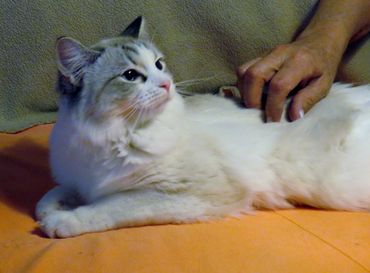Photos
Rag doll cats

Ragdolls, the world's best cats!
Rag doll cats
About the Ragdoll
Ragdolls are large, laid-back, semi longhaired cats with captivating blue eyes. The Ragdoll is a pointed breed, which means that the body is lighter in color than the points (the face, legs, tail and ears). The Ragdoll cat is carefully bred to produce large affectionate animals in three patterns, two with white (mitted and bi-color) and one with no white (colorpoint). The ideal Ragdoll is a well balanced cat, with no extreme features. Altered males will usually top the scale at 15-20 pounds; females are proportionately smaller and usually weigh between 10-15 pounds at maturity. Ragdolls are slow-maturing, reaching full coat color at two years, and full size and weight at four.
Ragdoll cats tend to be more interested in humans than some breeds of cats. They are known to run to greet you at the door, follow you from room to room, flop on you, sleep with you, and generally choose to be where you are. Many Ragdolls have been taught to come when called and play fetch. They are gentle cats, and usually play without extending their claws. Ragdolls tend to be floor cats, not jumpers. The Ragdoll’s semi long coat is plush and silky, and requires minimal grooming to keep it looking its best. They should be combed with a steel comb on a regular basis to find and remove any loose hair or tangles. Quality coats consist mainly of long, soft guard hairs. Ragdolls, just like all breeds of cats, will shed, usually with the change of seasons.The absence of the thick, dense, insulating undercoats results in reduced shedding and matting. In all, Ragdolls are well behaved, and easy to care for – perfect for our modern, busy, lifestyles.
There are four patterns: bi-color, van, mitted and colorpoint. Patterns come in six colors: seal, blue, chocolate, lilac, red, and cream. Points may be solid, lynx, tortie, or torbie (tortie and lynx). If you do the math, you can see that there are quite a large number of different combinations possible! CFA accepts bi-color and van patterns, mitted and colorpoints for showing in the full array of color combinations.
Colorpoint Ragdolls have the classic pointed markings with no white anywhere in their coat. Mitteds have white feet in the front and white boots that go all the way up and around the hock in the back, a white chin and belly stripe. Mitted Ragdolls may have a blaze, star or hourglass shaped patch of white on their forehead and nose. Bi-colors have more white; all four paws, their underbodies, chest, and an upside-down ‘V’ marking on their faces are white. They may have a splash or two of white on their backs. Only their tails, ears, and the outer part of their masks show the darker markings. In the Van pattern, only the top of the mask, ears, and tail, and perhaps a few spots on the body, show darker markings.
Ragdolls were developed in the 1960’s by Ann Baker; a breeder in Riverside California. The origin of the Ragdoll breed consisted almost entirely of free-roaming cats. Ann bred Josephine, a domestic longhaired white female that was found running loose in her neighborhood, to other cats she owned or found. The offspring of this female had unique temperament traits that were very endearing. By selecting individuals with the look, temperament and criteria she wanted for her breeding program, she created the Ragdoll breed.
Pricing on Ragdolls usually depends on type, applicable markings and bloodlines distinguished by Grand Champion (GC), National Regional winning parentage (NW or RW) or of Distinguished Merit parentage (DM). The DM title is achieved by the dam (mother) having produced five CFA grand champion/premier (alter) or DM offspring, or sire (father) having produced fifteen CFA grand champion/ premier or DM offspring. Usually breeders make kittens available between twelve and sixteen weeks of age. After twelve weeks, kittens have had their basic inoculations and developed the physical and social stability needed for a new environment, showing, or being transported by air. Keeping such a rare treasure indoors, neutering or spaying and providing acceptable surfaces (e.g. scratching posts) for the natural behavior of scratching (CFA disapproves of declawing or tendonectomy surgery) are essential elements for maintaining a healthy, long and joyful life.
6 Month old kittens available now!
2 female ond one male available sweet and playful!
Ready to be your new best friend!
Photo Gallery

















Copyright © 2018 Regal J Farms - All Rights Reserved.
Powered by GoDaddy